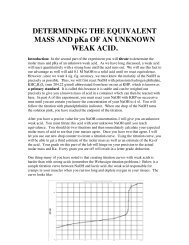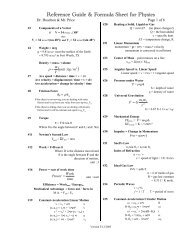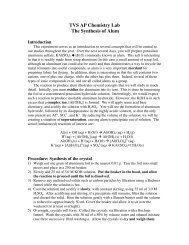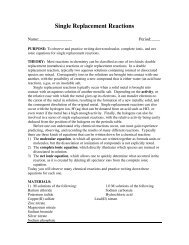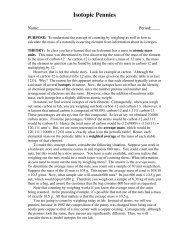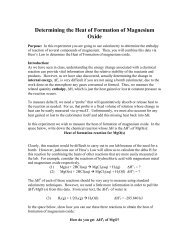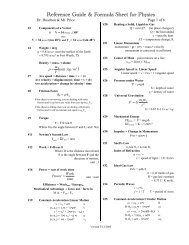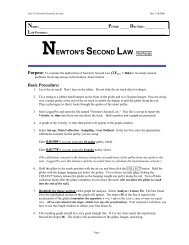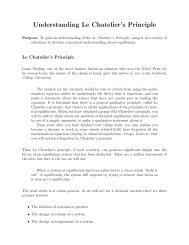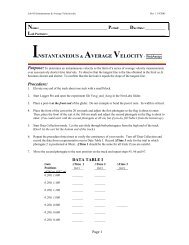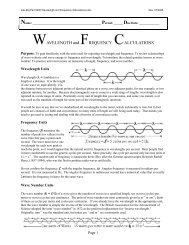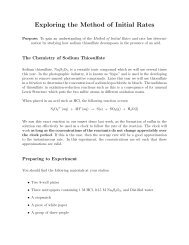Reference Guide & Formula Sheet for Physics - 2006 Version
Reference Guide & Formula Sheet for Physics - 2006 Version
Reference Guide & Formula Sheet for Physics - 2006 Version
Create successful ePaper yourself
Turn your PDF publications into a flip-book with our unique Google optimized e-Paper software.
<strong>Reference</strong> <strong>Guide</strong> & <strong>Formula</strong> <strong>Sheet</strong> <strong>for</strong> <strong>Physics</strong><br />
Dr. Mitchell A. Hoselton <strong>Physics</strong> − Douglas C. Giancoli Page 2 of 16<br />
Chapter 02. – Motion Along one Axis<br />
Physical quantities <strong>for</strong> which the direction of their<br />
motion or action is an important characteristic must be<br />
treated mathematically using vectors, not simple<br />
numerical values. Quantities that do not require<br />
directional in<strong>for</strong>mation are called scalars. We begin our<br />
study of vectors by studying motion in one direction.<br />
This type of vector behaves much like a scalar quantity;<br />
only the notation is a little different at this point.<br />
Vectors are symbolized with very bold letters. The<br />
most important quantities in this section are the<br />
instantaneous quantities listed here.<br />
Instantaneous position:<br />
Instantaneous position at time zero: x 0<br />
Instantaneous velocity:<br />
Instantaneous velocity at time zero: v 0<br />
Instantaneous acceleration:<br />
x<br />
v<br />
a<br />
(<strong>for</strong> now, acceleration is assumed to be constant.)<br />
Chapter 02. – continued<br />
With the definition of distance in hand we can define the<br />
scalar quantity known at the average speed.<br />
v AVG = average speed = distance/∆time = d/∆t<br />
Where ∆t is the time interval between the moment when<br />
the object was at the initial position and the moment<br />
when it was at the final position. The time interval is<br />
often writing simply as t, but this is only true if the time<br />
interval begins at the moment when the clock reads zero.<br />
(Think of the clock as a stopwatch.)<br />
With the definition of the displacement in hand we can<br />
define the vector quantity known as the average velocity<br />
v AVG = average velocity = displacement/∆time = d/∆t<br />
Instantaneous Position – x – the position of a moving<br />
object at one moment in time; also known as an instant<br />
of time. Position is always assumed to be instantaneous.<br />
Be<strong>for</strong>e we can rigorously define what we mean by<br />
instantaneous, we need to define some simpler<br />
quantities. The first of these are distance and<br />
displacement. In one dimension these might have the<br />
same numeric value.<br />
d = distance = odometer reading<br />
If the object starts at x 0 and moves back and <strong>for</strong>th<br />
be<strong>for</strong>e settling at its final position, x, then the distance<br />
could be much longer than the shortest path between the<br />
starting and ending points. On the other hand, the<br />
minimum distance is closely related to the displacement.<br />
d MIN = |x − x 0 | = |x 0 − x| = |d|<br />
The minimum distance does not include in<strong>for</strong>mation<br />
about the direction of travel; that is the meaning of those<br />
absolute value markers. The starting and ending<br />
positions are x 0 and x, but the scalar quantity called<br />
“minimum distance” does not care which is which.<br />
Subtraction in either order is permitted.<br />
d = displacement = x − x 0 = d<br />
The vector quantity called “displacement”, on the other<br />
hand, must be calculated as the final position vector<br />
minus the initial position vector. That result always<br />
gives us the minimum distance and the direction of the<br />
motion. For motion along the x-axis, as one example, a<br />
positive displacement indicates motion to the right. A<br />
negative displacement indicates motion to the left.<br />
<strong>Version</strong> 6/5/<strong>2006</strong><br />
Instantaneous Velocity – v – is average velocity over<br />
an infinitesimal displacement in an infinitesimal time<br />
interval. It is the velocity at one instant. As a practical<br />
matter it is usually good enough to measure the average<br />
velocity over a short displacement in a brief time interval<br />
and then take the ratio of those two measurements to<br />
estimate the instantaneous velocity.<br />
Constant-Acceleration Linear Motion<br />
Once our final definitions <strong>for</strong> instantaneous position and<br />
instantaneous velocity are completed, the following<br />
equations of motion apply to all systems that have a<br />
constant acceleration. (When the acceleration is constant, the<br />
instantaneous and average accelerations have the same magnitude and<br />
direction.)<br />
v = v 0 + a•t<br />
no x<br />
(x − x 0 ) = v 0 •t + ½•a•t² no v<br />
v² = v 0 ² + 2•a•(x − x 0 ) no t<br />
(x − x 0 ) = ½•(v 0 + v)•t no a<br />
(x − x 0 ) = v•t − ½•a•t² no v ο<br />
Average velocity can be obtained from the initial and<br />
final instantaneous velocities, if and only if the<br />
acceleration is constant.<br />
v AVE<br />
v + v<br />
=<br />
2<br />
0<br />
=<br />
average velocity





